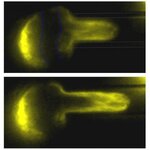Applied Physics

MIT researchers have created a new structured gel that can rapidly change color in response to a variety of stimuli, including temperature, pressure, salt concentration and humidity.
Among other applications, the structured gel could be used as a fast and inexpensive chemical sensor, says Edwin Thomas, MIT's Morris Cohen Professor of Materials Science and Engineering. One place where such an environmental sensor could be useful is a food processing plant, where the sensor could indicate whether food that must remain dry has been overly exposed to humidity.
A critical component of the…

Antimatter is made up of antiparticles in the same way that normal matter is made up of particles.
Antihydrogen, for instance, is the simplest atom comprised entirely of antiparticles, with an antiproton as a nucleus and a positron in place of the electron normally found in ordinary hydrogen.
Now a Swansea University physicist is leading a project worth more than £835,000, which could change our understanding of the structure of the Universe. Professor Mike Charlton has been awarded a five-year Senior Research Fellowship by the Engineering and Physical Sciences Research Council (EPSRC). The…

Slow or troubled healing processes are one of the many negative outcomes of diabetes and many other human diseases. Diabetes patients not only show deficient tissue healing of sharp wounds but they are also more prone to suffer from chronic wounds, such as ulcers in the lower limbs.
Looking for ways to improve the healing process in diabetes patients, the research group for the Traslacional Investigation of Biomaterials and Tissue Engineering of the “Universidad de Alcalá” managed by Doctor Juan Manuel Bellón and Doctor Julia Buján and working in collaboration with the CSIC have developed an…

Although nearly 500 people have died in the UK over the last 12 years as a result of accidental CO poisoning, small quantities of CO are produced naturally within the human body and are essential to life.
Chemists at the University of Sheffield have discovered an innovative way of using targeted small doses of CO which could benefit patients who have undergone heart surgery or organ transplants and people suffering from high blood pressure.
Although the gas is lethal in large doses, small amounts can reduce inflammation, widen blood vessels, increase blood flow, prevent unwanted blood…

On November 13-15 astronomers will meet at the "Astrophysics 2020: Large Space Missions Beyond the Next Decade" conference at the Space Telescope Science Institute in Baltimore, Md. to discuss the space observatories and science investigations that could be realized in the 2020-2030 decade.
Though the Hubble Space Telescope was launched in 1990, NASA started planning two decades earlier by establishing, in 1970, committees to plan the engineering of the space telescope and to determine the scientific goals of the mission.
The year 2020 is 13 years away, but astronomers now need to start…

In process that is shrouded in mystery, rod-shaped bacteria reproduce by splitting themselves in two. By applying advanced mathematics to laboratory data, a team led by Johns Hopkins researchers has solved a small but important part of this reproductive puzzle.
The findings apply to highly common rod-shaped bacteria such as E. coli, found in the human digestive tract. When these single-celled microbes set out to multiply, a signal from an unknown source causes a little-understood structure called a Z-ring to tighten like a rubber band around each bacterium’s midsection. The Z-ring pinches the…

Biophysicists at the University of Pennsylvania have discovered that the nuclei of human stem cells are particularly soft and flexible, rather than hard, making it easier for stem cells to migrate through the body and to adopt different shapes, but ultimately to put human genes in the correct nuclear ¡°sector¡± for proper access and expression.
Researchers pulled cell nuclei into microscopic glass tubes under controlled pressures and visualized the shear of the DNA and associated proteins by fluorescence microscopy. The study showed that nuclei in human embryonic stem cells were the most…

Natural gas ( methane ) has a greater global warming impact than carbon dioxide but conventional cellulose acetate membranes in processing plants lose natural gas in their waste products.
Thermally rearranged (TR) plastic works four times better than conventional membranes at separating out carbon dioxide, say University of Texas at Austin researchers. Dr. Ho Bum Park, a postdoctoral student in the laboratory of Professor Benny Freeman, also found that TR plastic membranes act quicker. They permit carbon dioxide to move through them a few hundred times faster than conventional membranes do…

Verbs evolve and homogenize at a rate inversely proportional to their prevalence in the English language, according to a formula developed by Harvard University mathematicians who've invoked evolutionary principles to study our language over the past 1,200 years, from "Beowulf" to "Canterbury Tales" to "Harry Potter."
Writing this week in the journal Nature, Erez Lieberman, Jean-Baptiste Michel, and colleagues in Harvard's Program for Evolutionary Dynamics, led by Martin A. Nowak, conceive of linguistic development as an essentially evolutionary scheme: Just as genes and organisms undergo…

The ability to tactually recognize fine spatial details, such as the raised dots used in braille, is especially important to those who are blind. With that in mind, a team of researchers has identified the neural circuitry that facilitates spatial discrimination through touch. Understanding this circuitry may lead to the creation of sensory-substitution devices, such as tactile maps for the visually impaired.
The research team, led by Krish Sathian, MD, PhD, professor of neurology in Emory University School of Medicine, included first author Randall Stilla, research MRI technologist at Emory…